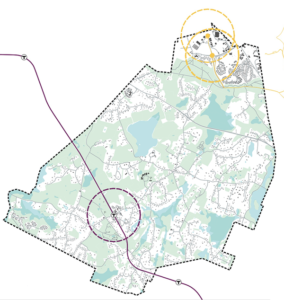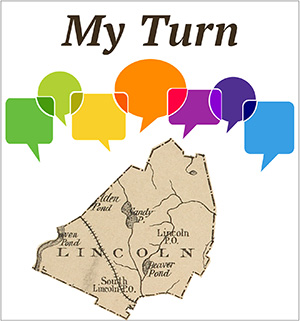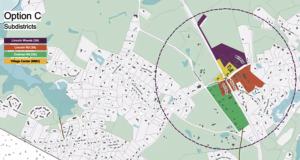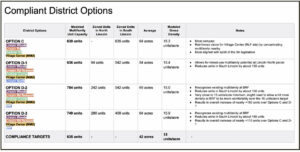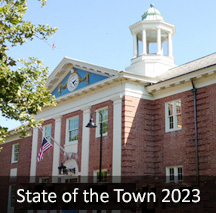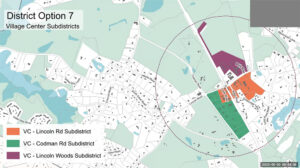(Editor’s note: this article was updated on November 26 with the correct vote totals.)
Residents will have a fifth Housing Choice Act option to choose from in the vote at the Special Town Meeting on December 2 — an option that adds allowed-by-right multifamily housing in various parts of town but removes them from the mall.
On November 14, the Select Board (on the recommendation of the Housing Choice Working Group) voted to allow residents to submit proposals in addition to the four they already agreed on (Options C, D1, D2, and D3). if they did so by noon on November 20. Lincoln Residents for Housing Alternatives (LRHA) submitted Option E, which town officials have sent to consultant Utile to review. The plan calls for adding allowed units around the Ryan Estate, Lincoln Woods, and Battle Road Farm. It also excludes the Doherty’s parcel and the north side of Lewis Street, which has some structures that are historically significant although they are not in an official historic district.
They argue that the mall’s commercial and housing redevelopment should not be included in the HCA planning because it would surrender residents’ ability to vote yes or no on a developer’s proposal at Town Meeting. Mall rezoning should be drawn up and voted on separately at Town Meeting in March, they say.
“This optimizes the town of Lincoln’s control of how we meet the HCA requirements — it meets the spirit and the letter,” Frank Clark of LHRA said at the HCAWG’s November 21 morning meeting. “Our option absolutely preserves the best flavor of Lincoln… this is probably the simplest and most low-impact method of meeting the requirements.”
“To me, the spirit of the law means a chance for more housing,” Select Board member Jennifer Glass said, noting that even if were to be technically allowed, more multifamily housing is very unlikely to be built around the Ryan Estate, Lincoln Woods, and Battle Road Farm. Option E triples the allowed density of housing at Battle Road Farm, but it’s a condo community in which every single condo owner would have to agree to a proposal by a developer.
“We’re trying to avoid actively talking about the spirit of law because it has no real meaning when you think about it profoundly,” responded LRHA member David Cuetos, who added, “Every one of us has a different interpretation of what the spirit of the law is.”
The goal of the HCA was “to create a likelihood of meaningful housing near MBTA stations,” committee member John MacLachlan said. “To ask us to vote for [Option] E is demeaning and belittling what we have done for a year…. Option E is essentially a vote to say no to the HCA.”
The future of the mall
“From a planning perspective, it seems to make sense to think about [rezoning] holistically, as the [HCAWG] has tried to do,” said Michelle Barnes, chair of the RLF Board of Trustees, which owns the mall. There has been speculation that the RLF intends to reduce the amount of commercial square footage (presumably because a greater concentration of housing would be more profitable for developers).
“It’s definitely not our intention to reduce any commercial footprint at the mall,” she said.
In a November 20 email to the Lincoln Squirrel, Barnes elaborated: “All of our plans to date are conceptual so we do not yet know how much commercial space will be provided. Some of our current tenants may want less space, some may want more space and some may not want to continue operating at the Mall at Lincoln Station. We also would anticipate that any redevelopment may involve new tenants locating to the mall. As part of any redevelopment scenario, RLF’s goal will be to work with all of our existing tenants to accommodate their needs consistent with the economic viability of the mall. We are hoping to achieve more flexibility than we currently have to respond to tenants’ needs and market forces, while still maintaining a significant and meaningful footprint of retail and commercial space at the mall.”
Barnes also responded in her email to fears that Donelan’s was at risk of leaving the mall. “RLF feels it is critical for both the social and financial fabric of the Mall to have a well-appointed grocery store. As demonstrated when the roof collapsed in 2011 and Donelan’s was at serious risk of leaving, RLF is fully committed to trying to maintain a grocery option at Lincoln Station,” she wrote.
No other supermarket chain has expressed interest in the space, she added. “We are hopeful that increased density around the mall, along with the changing risk-return profile from new mixed-use development at the mall, would provide support to Donelan’s and other retail businesses. Ultimately, Lincoln residents control the future of a grocery store and other retailers at the mall by either shopping there in sufficient numbers or not.”
Barnes has said in the past that the RLF hopes to work with Civico (which built Oriole Landing) to design a mutually acceptable mall project, with the possibility of Civico eventually buying the property from the RLF. At the Wednesday meeting, she said “a sale is one of the potential results… but the person who purchases it isn’t necessarily the partner we’ve had this historical relationship with.” However, “we are predicating” any future sales agreement on inclusion of deed restrictions that would mandating a certain proportion of commercial use in perpetuity.
If rezoning the mall to allow some housing were brought to a Town Meeting as a separate issue, “you’d be asking the town to approve a number of units above and beyond what the HCA requires” in addition to Option E, said HCAWG member Rachel Drew. “Including the mall in the HCA is efficient because it tries to accommodate both of these objectives at the same time.”
Split vote by working group
The working group subsequently voted to recommend that the Select Board add Option E to the December 2 ballot when that board meets on November 21. Seven voted in favor: Barnes, Jennifer Glass, Andrew Glass, Darin LaFalam, Tim Higgins, Geoff McGean, and Terry Perlmutter. Gary Taylor and Kathy Shepard voted no, while the others at the meeting (Rachel Drew, Steve Gladstone, and Paula Vaughn-MacKenzie) abstained.
Glass also shot down previous requests that “none of the above” should be a choice on December 2. “The time to say ‘none of the above’ is in March when it’s an up-and-down vote,” she said.
